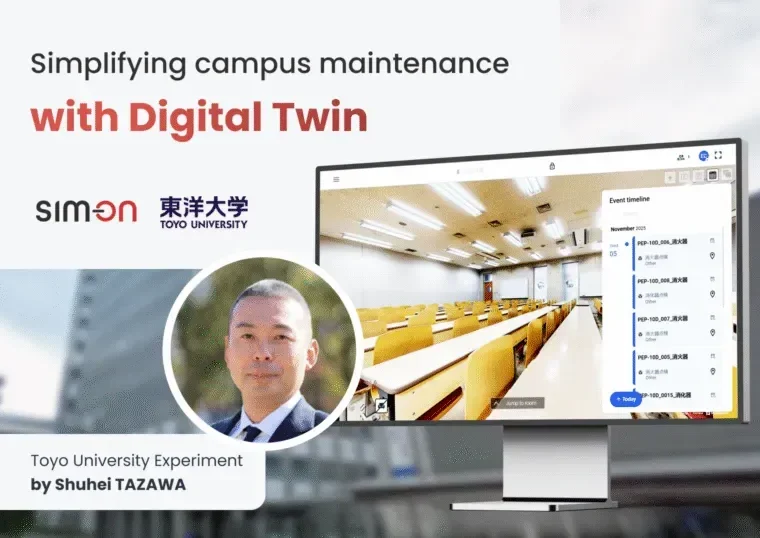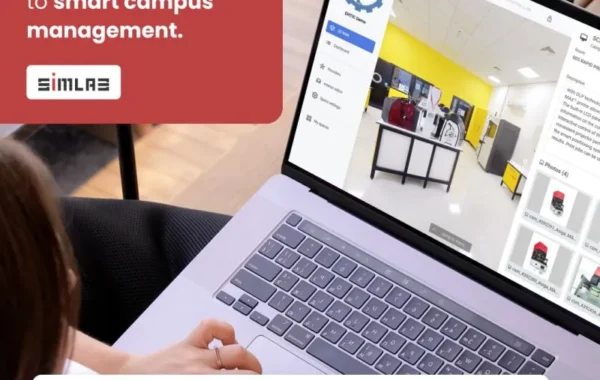Managing university facilities often means dealing with paper archives, scattered PDFs, and disconnected systems like CMMS and BMS. Toyo University decided to try something different: a 3D spatial interface powered by Matterport Digital Twin and SIM-ON, where documents, manuals, event history, and tasks are all accessible directly from the building’s digital map. The outcome? Significantly reduced information search times, fewer communication mistakes, and a centralized work history.
Key Points Covered:
Digital transformation challenges on university campuses
SIM-ON as a spatial building management solution
Toyo University’s experimental approach
Measurable results and insights
Implications for higher education facilities
Core Findings
The starting challenge involved paper-based systems, 2D drawings, and fragmented files, leading to extended search times and increased error risks during staff transitions.
The solution came through SIM-ON functioning as maintenance GPS—users simply click objects in the 3D model to instantly access relevant manuals, service history, photos, maintenance schedules, and IoT/BMS data.
Toyo University’s test demonstrated impressive results:
HVAC system failures were resolved 55% faster (dropping from 5 hours 50 minutes to 2 hours 36 minutes)
Beyond time savings, the system provided timeline visualization for planned work, integrated ticketing with task assignments, and improved cross-department communication consistency.
Campus Facility Management Challenges
University facilities teams frequently struggle with fragmented documentation and disconnected tools. Toyo University identified this clearly: paper-based maintenance tied to 2D drawings creates bottlenecks because information remains scattered and difficult to locate during inspections or repairs.
Professor Shuhei Tazawa from Toyo University’s School of Architecture led an experiment testing whether a spatial management interface built on Matterport scanning and SIM-ON could genuinely reduce time requirements and organize Facility Management processes more effectively.
Understanding SIM-ON’s Spatial Approach
SIM-ON integrates a 3D model captured with Matterport, technical documentation, service records, IoT/BMS data, and maintenance workflows. Rather than searching for filenames, users click devices within the model to immediately view manuals, wiring diagrams, piping layouts, as-built photographs, ticket histories, and upcoming inspection schedules.
At Toyo, 112 assets received digital tags including fire extinguishers, hydrants, HVAC equipment, emergency lighting, fire doors, and speakers. Each asset connected to PDFs, images, videos, alarm data, and inspection schedules—all accessible through the virtual object.
SIM-ON also provides ticketing functionality with task assignments, priorities, and status tracking, plus an event timeline for tracking activities, timing, and responsible personnel.
The Toyo Experiment Structure
The scope involved selecting a building, capturing a Matterport Pro2 scan, and generating a 3D model. Operational data was integrated into the model, and mandatory inspection items were exported to COBie format, creating a consistent as-built record with inspection layers.
Two approaches were compared:
Traditional workflow using paper, 2D drawings, network folders with PDFs, and separate CMMS/BMS systems
Measured FM activities included finding instructions and plans, logging faults, assigning technician tasks, and updating statuses. The team simulated an HVAC failure and conducted speed tests for accessing maintenance histories and schedules.
Measured Outcomes
HVAC outage response showed dramatic improvement. The traditional method required 5 hours 50 minutes, while Digital Twin implementation with SIM-ON needed only 2 hours 36 minutes—approximately 55% less labor time. This reduction resulted from direct model access to specifications and device history, combined with unified communication streams for photos, notes, and status updates.
Maintenance history and schedule access became exponentially faster. Traditional methods took 11 minutes 52 seconds, while Digital Twin access required just 56 seconds—a 92% time reduction. This improvement came from eliminating the translation step between room numbers, inventory codes, and folder paths—clicking objects opened correct records immediately.
Communication clarity and accountability improved substantially. One unified 3D model combined with timeline and ticketing features kept teams aligned and reduced disputes about correct file versions. Shift handoffs and activity audits simplified because everything referenced physical locations.
Organizational insights emphasized that cultural change matters as much as technology. Long-standing vendor habits can prevent knowledge centralization with building owners. SIM-ON enables owners to truly master building geometry and inspection requirements, delivering better returns and lower costs through proactive FM.
Higher Education Implications
Digital Twins serve dual purposes beyond operations—they function as teaching platforms. Architecture, construction, and engineering students can study actual installations, simulate scenarios, and design optimizations on functioning campuses.
The integration ecosystem connects SIM-ON with IoT/BMS endpoints like KNX and NETxAutomation, plus EAM/CMMS platforms such as IBM Maximo, creating unified spatial interfaces for technical, service, and operational data. The experiment successfully connected existing building automation systems to SIM-ON with successful KNX sensor readings, confirming broader application readiness.
Environmental and efficiency benefits include reduced paper usage and improved energy management. Sensor data viewed in spatial context accelerates energy anomaly detection and enhances occupant comfort, aligning with centralized information management and tighter inspection control.
Final Thoughts
Toyo University’s experience proves Digital Twins function as practical operational tools beyond aesthetic models. Combined with SIM-ON, the technology reduces response times, accelerates document searches, streamlines communication, and establishes a single source of truth from initial tickets through final reports. The fundamental shift moves from folder hunting to direct 3D object interaction.







